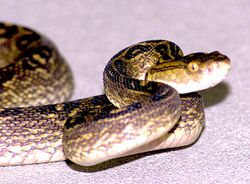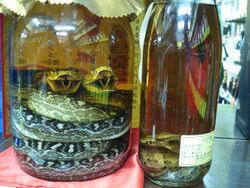Biology:Protobothrops flavoviridis
| Protobothrops flavoviridis | |
|---|---|

| |
| Scientific classification | |
| Domain: | Eukaryota |
| Kingdom: | Animalia |
| Phylum: | Chordata |
| Class: | Reptilia |
| Order: | Squamata |
| Suborder: | Serpentes |
| Family: | Viperidae |
| Genus: | Protobothrops |
| Species: | P. flavoviridis
|
| Binomial name | |
| Protobothrops flavoviridis (Hallowell, 1861)
| |
| Synonyms[1] | |
| |
Protobothrops flavoviridis is a species of venomous pit viper endemic to the Ryukyu Islands of Japan .[2][3] No subspecies are currently recognized.[3][4] Local common names include habu,[2][3][5] Okinawa habu,[6] and Kume Shima habu.[7]
Description
Growing to an average total length of 4–5 feet (120–150 cm), with a maximum of 7.9 feet (240 cm),[8] this is the largest member of its genus. It is slenderly built and gracefully proportioned with a large head. The crown of the head is covered with small scales. P. flavoviridis has a light olive or brown ground color, overlaid with elongated dark green or brownish blotches. The blotches have yellow edges, sometimes contain yellow spots, and frequently fuse to produce wavy stripes. The belly is whitish with dark coloring along the edges.[6]
Distribution and habitat
Protobothrops flavoviridis is restricted to the Japanese Ryukyu Islands, including Okinawa and the Amami Islands.[2][3] The type locality is "Amakarima Island (one of the Loo-Choo group)" (= Keramashima, Ryukyu Islands).[1] It is common on the larger volcanic islands, but not present on the smaller coral islands.[6]
The species is often reported from the transition zone between palm forest and cultivated fields. It may also be found on rock walls and in old tombs and caves.[6]
Ecology
The species is terrestrial[7] and mostly nocturnal. It often enters homes and other structures in search of rats and mice. Bold and irritable, it can strike quickly and has a long reach.[6]
Unlike most pit vipers, P. flavoviridis is oviparous and lays eggs, rather than bearing live young.[6] Mating takes place in early spring and up to 18 eggs are laid in mid-summer. The hatchlings, which emerge after an incubation period of 5–6 weeks, are 25 centimetres (10 in) in length and look the same as the adults.[7]
To reduce the population of P. flavoviridis on the island of Okinawa, the small Asian mongoose (Herpestes javanicus), was introduced in 1910. Although the effects of this introduction have not been studied, in other such cases the negative effects on species of native birds, mammals, and herpetofauna have been a source of concern for wildlife managers.[9]
Venom
The incidence of snakebite in the Amami Islands is 2 per 1,000 people, which is considered very high. The venom of this species is of high toxicity, containing cytotoxin and haemorrhagin[check spelling] components,[10] yet the fatality rate is less than 1%.[11] A bite from a habu snake can cause nausea, vomiting, hypotension, and possibly death. There have been cases where victims report the loss of motor function in hands and legs following treatment.[12] If a bite victim receives medical care promptly, bites are not life-threatening. However, 6–8% do suffer permanent disability.[6]
-1">50 values of 3.1, 4.3, 3.7, 2.7, 3.7, 3.8 mg/kg IV, 5.1 mg/kg IP and 6.0, 3.5-5.0, 4.5 mg/kg SC have been reported for the venom.[13]
Usage by humans
On the island of Okinawa, this species is heavily collected, primarily for use in habushu (ハブ酒). In this case, the sake is a liquor called awamori (泡盛), alleged to have medicinal properties. As is typical with snake wine, the snakes may be inserted into the container while still alive, causing them to drown, or the snake may be stunned first and gutted while still alive. The production includes the body in the fermentation process and it is sold in bottles that may or may not retain the body of a snake (or other animals such as lizards or scorpions).[14]
See also
- Snakebite
- Habushu
References
- ↑ 1.0 1.1 McDiarmid RW, Campbell JA, Touré TA (1999). Snake Species of the World: A Taxonomic and Geographic Reference, Volume 1. Washington, District of Columbia: Herpetologists' League. 511 pp. ISBN:1-893777-00-6 (series). ISBN:1-893777-01-4 (volume).
- ↑ 2.0 2.1 2.2 Cite error: Invalid
<ref>tag; no text was provided for refs namedIUCN - ↑ 3.0 3.1 3.2 3.3 Protobothrops flavoviridis at the Reptarium.cz Reptile Database. Accessed 13 August 2022.
- ↑ "Protobothrops flavoviridis". Integrated Taxonomic Information System. https://www.itis.gov/servlet/SingleRpt/SingleRpt?search_topic=TSN&search_value=1058439. Retrieved 13 August 2022.
- ↑ Gumprecht A, Tillack F, Orlov NL, Captain A, Ryabov S (2004). Asian Pitvipers. 1st Edition. Berlin: GeitjeBooks. 368 pp. ISBN:3-937975-00-4.
- ↑ 6.0 6.1 6.2 6.3 6.4 6.5 6.6 U.S. Navy (1991). Poisonous Snakes of the World. New York: US Government / Dover Publications Inc. 203 pp. ISBN:0-486-26629-X.
- ↑ 7.0 7.1 7.2 Mehrtens JM (1987). Living Snakes of the World in Color. New York: Sterling Publishers. 480 pp. ISBN:0-8069-6460-X.
- ↑ "沖縄県における平成 23 年の毒蛇咬症". Archived from the original on 2014-12-17. https://web.archive.org/web/20141217232633/http://www.eikanken-okinawa.jp/news/news23/image/23page1.pdf. Retrieved 2013-02-25.
- ↑ Hays, Warren S. T.; Conant, Sheila (2007). "Biology and impacts of Pacific island invasive species. 1. A worldwide review of effects of the small Indian mongoose, Herpestes javanicus (Carnivora: Herpestidae)". Pacific Science 61 (1): 3–16. doi:10.1353/psc.2007.0006. http://scholarspace.manoa.hawaii.edu/bitstream/10125/22595/1/vol61n1-3-16.pdf.
- ↑ O'Shea, M. (2008). Venomous Snakes of the World. Sydney: New Holland Publishers.
- ↑ "沖縄県における平成 23 年の毒蛇咬症". Archived from the original on 2013-05-02. https://web.archive.org/web/20130502171348/http://www.eikanken-okinawa.jp/seitaiG/habu/houkokusyo/H23houkoku.pdf. Retrieved 2013-03-11.. According to this report, 8901 snakebites from this snake are reported during 1964-2011 in Okinawa prefecture(Amami excluded). Among those, fatalities are 53. So, fatality rate is around 0.6%.
- ↑ "An experimental study of emergency care for habu bites : estimation of amount of venom removed by suction". Ryukyu Medical Association. 5 (3): 196–200. 1982.
- ↑ Brown, John Haynes (1973). Toxicology and Pharmacology of Venoms from Poisonous Snakes. Springfield, Illinois: Charles C. Thomas. ISBN 0-398-02808-7. https://archive.org/details/toxicologypharma0000brow.
- ↑ "Okinawa's potent habu sake packs healthy punch, poisonous snake". Archived from the original on 27 December 2008. https://web.archive.org/web/20081227062048/http://www.stripes.com/01/mag/sm072201c.html. Retrieved 2008-12-07.
Further reading
- Hallowell E (1861). "Report upon the Reptilia of the North Pacific Exploring Expedition, under command of Capt. John Rogers, U. S. N." Proceedings of the Academy of Natural Sciences of Philadelphia 12: 480–510. (Bothrops flavoviridis, new species, pp. 492–493).
External links
Wikidata ☰ Q46112 entry
 |




